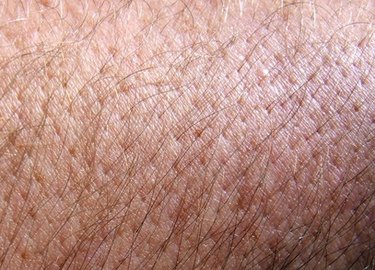Things You'll Need
Styrofoam craft ball, 5-inch diam.
Package of multicolored markers, 8-count
Styrofoam cutter
Styrofoam craft ball, 3-inch diam.
Ruler
Hot glue gun
Package of multicolored, construction paper
Scissors
Package of multicolored, modeling clay
Package of toothpicks
Sheet of white printing paper
Fine-tip pen or marker
Invisible tape

Every cell in your body is like a mini energy factory. Your cells have parts, called organelles, that each perform various functions to absorb nutrients from your food and convert them into energy. This simple project of creating a 3D model of a human cell is a great way to learn about the parts of the cell. This project is great for schoolchildren.
Step 1
Trace the circumference of the 5-inch styrofoam ball by drawing a line around its center. Cut the ball in half with the styrofoam cutter. You will only need one of the halves for this project. Cut the 3-inch styrofoam ball in half, then cut the top 1/2-inch off of one of the halves. You will have a piece that looks like a small rice cake. Glue this disk into the center of the larger, 5-inch styrofoam half.
Video of the Day
Step 2
Color the exterior of the large styrofoam half (the one you chose to work with) with one of the markers. Color the top of the large styrofoam half with another color. Next, color the sides and outer edges of the small disk with a third color of marker. Lastly, color the top of the disk with a fourth color of marker. The large ball is the main part of the cell and the small disk is the nucleus.
Step 3
Take out one sheet of construction paper. Cut three 1/2-inch wide strips from the sheet (lengthwise or widthwise, it does not matter). Fold the strips accordion-style by 3-inch intervals so that you have three, thick, lasagna-like pieces. The folded ends should still be rounded and not pressed down flat. Glue each of these pieces around the smaller, styrofoam disk in the center of the ball. This is called the rough endoplasmic reticulum.
Step 4
Take out two sheets of construction paper, each of two different colors and different from the last sheet. Cut one 1/2-inch strip from each of the sheets of paper. Fold each sheet in 1-inch intervals, again accordion-style. The ends of the folds should not line up perfectly, but should be more random (see picture in Resources). Dig two 1/4-inch craters into two different areas on the top of the 5-inch styrofoam ball, close to the edges. Glue one folded strip into each crater. These are the Golgi apparatus and the smooth endoplasmic reticulum.
Step 5
Open the modeling clay and pull off a walnut-sized lump from two different colors of clay. From one lump, remove two, pea-sized balls and roll into pill shapes. Glue these two shapes next to each other on top of the 5-inch styrofoam ball (These are the centrioles.) From the other lump, make about ten tiny balls (smaller than peas). Glue these balls to various areas around the smaller disk on the styrofoam ball (these are ribosomes). Then, take the remainder of that lump, roll it into a ball and glue that ball directly into the center of the smaller disk.
Step 6
Pull off another walnut-sized lump from another color of clay, different from the other two. Divide this lump into three, equal pieces. Roll these pieces into pill shapes, then use a toothpick to draw a curvy snake shape into the surface of each shape. Glue these pieces onto the surface of the larger, styrofoam ball. These are mitochondrions.
Step 7
Write the following words on the sheet of paper: Centrioles, Cell Membrane, Golgi Apparatus, Mitochondrion, Nuclear Envelope, Nucleus, Nucleolus, Ribosomes, Rough Endoplasmic Reticulum, Smooth Endoplasmic Reticulum. Cut these words out of the paper in small strips. Tape each word to a toothpick and insert that toothpick into the cell model next to the object it represents. Use the picture in Resources as a guide.
Video of the Day